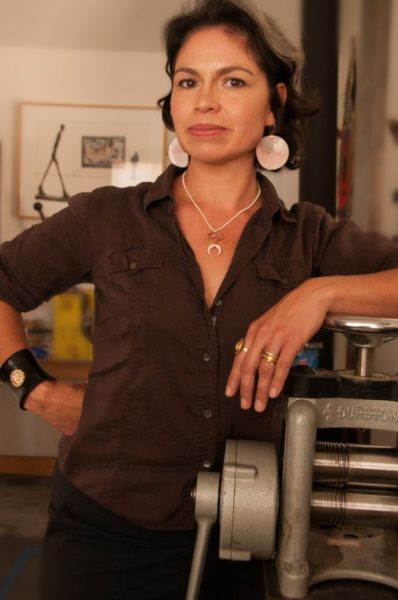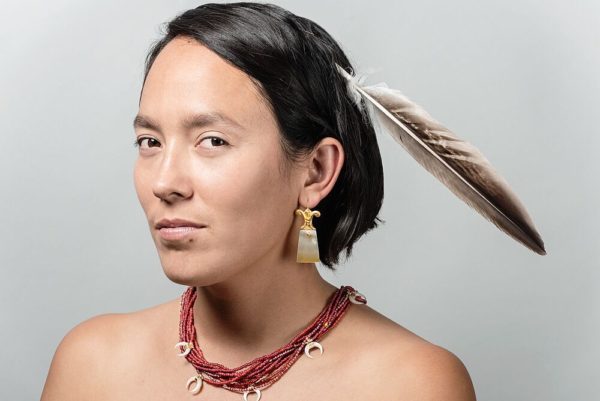
- Details
- By Rich Tupica
SANTA FE, N.M. — Keri Ataumbi, owner of Ataumbi Metals, is one of the many countless entrepreneurs who’s swiftly recalibrating her life and business as the world hunkers down in hopes of flattening the COVID-19 curve. The metalsmith runs her jewelry and wearable-art business out of Santa Fe, New Mexico, a vibrant city known for its booming art scene.
There, she creates contemporary Native American jewelry and other self-made, one-of-a-kind fine art pieces. Ataumbi, a member of the Kiowa Tribe, was raised by her Kiowa mother and Italian father on the Wind River Reservation in Wyoming. It was there she was exposed to both traditional Native American and contemporary aesthetics, which ultimately led her to earning an art degree and starting her own business. “My work is a means to share the experience of being part of a living vibrant culture that is so often perceived as being a relic of the past,” she told Native News Online. “It’s my duty as an artist and a Kiowa woman to keep our aesthetics alive for the next generation.”
Currently she works and lives with her husband in the country, tending to their honeybees, orchard, organic vegetable garden, dogs and cats. Of course, right now she also has plenty of time to reflect on life and her future. Here’s what she had to say in an interview with Native News Online.
Native News Online: With the COVID-19 outbreak happening across the world, how has it affected your business so far? Keri Ataumbi: My business has come to a screeching halt. I am paying attention to the news and trying to formulate a plan of how I should move forward. I’m finding myself thinking about making pieces that I’ve wanted to do, but haven’t had the time to. I am also using the time to reset.
How does being a Native American artist affect your jewelry and other artworks? I navigate the cultural and aesthetic boundaries of being an Indigenous artist. Some of those boundaries are rooted in our own tribal expectations while others are dictated by the market. I have been told that my work “doesn’t look Indian” by non-natives because it did not fit their perception of what is and is not contemporary Native-looking jewelry. Native tradition is a set of principles and values that provides a foundation for change rather than an immutable rule or practice. Through tradition we stay connected to who and where we come from and have the means to pass that wealth to the next generation.
 A model poses with pieces from Ataumbi’s collection. (courtesy photo)
A model poses with pieces from Ataumbi’s collection. (courtesy photo)
What do you hope people get out of your artwork? I’m interested in making work that acts to change the current platform of contemporary Native adornment defined by objects that conform to material choices and/or an aesthetic that is considered “traditional.” I’m interested in making work that transmutes the philosophical and ceremonial continuums that are the backbone of our identities as Native Americans. I am also interested in the value systems that different cultures put upon materials and objects. I believe the work is an opportunity to create a dialogue between cultures that can serve to educate and possibly highlight the common points of being human through story, myth and beauty.
Business aside, how has the COVID-19 crisis affected your daily routine? I’m a natural hermit, like most artists, so my daily routine hasn’t changed much. I live away from town and usually only go to town once a week. I am now only going into town once every 14 days now. After I did a serious deep cleaning of my shop, my workflow has shifted from inside my shop to outside. I’ve been building cold frames and prepping the soil for planting this year. I grow a vegetable garden and this year it seems imperative to have one. I had a five week residency planned at Ucross in Wyoming that was postponed, which was very sad, but has allowed me to have the time to take care of my family and property.
Are you able to plan for the future right now? I’ve been spending the last few weeks allowing myself to slow down and listen. I’m not sure what direction to take my company in because what I make is entirely dependent on peoples’ disposable income. I am also dependent on art shows like SWAIA, which is not that far off in August. We’re all unsure what things will look like then economically or whether people will feel safe being at an event with large crowds. I also have a show planned overseas at the end of the year. Both of these events require me to build an inventory for them. I’m trying to figure out what kind of inventory and how I can build them without serious financial risk because of my material costs.
I’ve noticed quite a few Native artists are getting creative with live streams right now, what are your thoughts on that? In this time of social distancing, I have been very impressed with how the Native art community has come together. Examples would be the series of virtual beading circles Tania Larsson (Gwich’in) started and was written about by Christian Allaire (Ojibwe) for vogue.com or Jamie Okuma (Shoshone Bannock and Luiseño) who is gifting beading kits and a live Zoom tutorial to a certain number of people who buy one of her collaborations with several small Indigenous businesses. Tony Abeyta has been doing painting tutorial videos on social media platforms. These ways of learning from each other, sharing and supporting each other are old ways and this is good to see them in practice. To check out Keri Ataumbi’s collections of work, click here.
More Stories Like This
American Basketball Association Announces Native ABA InitiativeFour Winds South Bend Upgrades to Class III Gaming Casino
Native News Online Wins Two Awards from Native American Journalists Association
Wahlberg Brothers Are a Big Hit at Indian Gaming Tradeshow and Convention in Las Vegas
Native Gro Offers Tribes a ‘One-Stop Shop’ for Entering the Cannabis Industry
Help us defend tribal sovereignty.
At Native News Online, our mission is rooted in telling the stories that strengthen sovereignty and uplift Indigenous voices — not just at year’s end, but every single day.
Because of your generosity last year, we were able to keep our reporters on the ground in tribal communities, at national gatherings and in the halls of Congress — covering the issues that matter most to Indian Country: sovereignty, culture, education, health and economic opportunity.
That support sustained us through a tough year in 2025. Now, as we look to the year ahead, we need your help right now to ensure warrior journalism remains strong — reporting that defends tribal sovereignty, amplifies Native truth, and holds power accountable.
 The stakes couldn't be higher. Your support keeps Native voices heard, Native stories told and Native sovereignty defended.
The stakes couldn't be higher. Your support keeps Native voices heard, Native stories told and Native sovereignty defended.
Stand with Warrior Journalism today.
Levi Rickert (Potawatomi), Editor & Publisher
